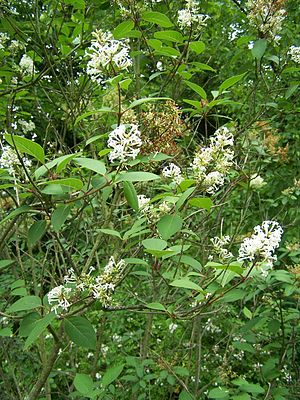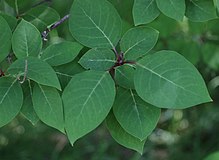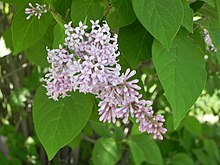Himalayan lilac
| Himalayan lilac | ||||||||||||
|---|---|---|---|---|---|---|---|---|---|---|---|---|

Himalayan lilac ( Syringa emodi ) |
||||||||||||
| Systematics | ||||||||||||
|
||||||||||||
| Scientific name | ||||||||||||
| Syringa emodi | ||||||||||||
| Wall. ex Royle |
The Himalayan lilac ( Syringa emodi ) is a shrub with pale purple to white flowers from the family of Olive Family (Oleaceae). The natural range is in India, Nepal and Pakistan. The species is often used as an ornamental shrub.
description
The Himalayan lilac is a 2 to 5 meter high, stiffly upright shrub with thick, brownish or dark olive-green branches covered with lighter cork pores . Terminal buds are present. The leaves are divided into a petiole and a leaf blade. The stem is 1 to 1.5 inches long, the base of the stem is purple. The leaf blade is leathery, simple, up to 9 centimeters long and 5 centimeters wide, with entire margins, elliptical to elongated, short pointed and with a narrowed base. The upper side of the leaf is deep green and bare, the underside is densely warty, smooth, whitish or blue-green and slightly hairy on young leaves. The leaf veins are protruding.
The fragrant flowers grow in 8 to 18 centimeters long, dense, fairly broad and finely hairy panicles with basal leaves. The corolla is white to purple in color. The corolla tube is narrow and about 8 millimeters long, the corolla lobes are shorter, linear-elongated and turned back. The dust bags are excellent. Cylindrical, slightly curved and pointed, smooth or somewhat warty capsules are formed as fruits, which are 15 millimeters long and 4 millimeters in diameter and open in two halves. The Himalayan lilacs bloom from May to July, the fruits ripen from September to October.
distribution
The natural range is in Asia in northwest India, in the north of Pakistan, in Afghanistan and Nepal. It also occurs in Tibet (Jilang Xian). The Himalayan lilac grows in cool, moist forests on slightly acidic to alkaline, humus-rich or sandy-loamy soils in sunny locations. The species loves warmth and is usually frost hardy . It is assigned to winter hardiness zone 5a with mean annual minimum temperatures of −26.0 to −23.4 ° C. In Pakistan one finds the species up to the subalpine zone at altitudes of 2000 to 3000 meters.
Systematics
The Himalayan lilac ( Syringa emodi ) is a kind from the kind of lilacs ( Syringa ) in the family of Olive Family (Oleaceae). There she is assigned to the tribe Oleeae. The species was by John Forbes Royle in 1835 for the first time scientifically valid described . The genus name Syringa was chosen by Linné in 1753, previously from the 16th century the name was used both for the common lilac ( Syringa vulgaris ) and for the European pipe bush ( Philadelphus coronarius ). The name can probably be derived from the Greek "syrigs", a wind instrument that can be made from the branches of the pipe bush. The specific epithet emodi is derived from "Emodos", a mountain range in the Karakoram and Himalayas recorded on Ptolemy's map of the world and thus refers to the range of the species in the Himalayas. According to R. Govaerts, Syringa tibetica P.Y.Pai is also a synonym of the Himalayan lilac and is therefore also found in Tibet.
use
The Himalayan lilac is often used as an ornamental shrub because of its decorative and fragrant flowers . In Pakistan, its leaves are also used as food for goats.
proof
literature
- Andreas Roloff , Andreas Bärtels: Flora of the woods. Purpose, properties and use. With a winter key from Bernd Schulz. 3rd, corrected edition. Eugen Ulmer, Stuttgart (Hohenheim) 2008, ISBN 978-3-8001-5614-6 , pp. 638-639.
- Jost Fitschen: Woody flora . 12th, revised and expanded edition. Quelle & Meyer, Wiebelsheim 2007, ISBN 3-494-01422-1 , p. 827 .
- Helmut Genaust: Etymological dictionary of botanical plant names. 3rd, completely revised and expanded edition. Nikol, Hamburg 2005, ISBN 3-937872-16-7 (reprint from 1996).
Individual evidence
- ^ German name according to Roloff et al .: Flora der Gehölze , p. 638 and according to Fitschen: Gehölzflora , p. 827
- ↑ Fitschen: Gehölzflora , p. 827
- ^ A b c d e Roloff et al .: Flora of the Woods , pp. 638–639
- ↑ a b c d e Syringa emodi. In: Flora of Pakistan. www.eFloras.org, p. 238 , accessed on June 20, 2012 (English).
- ↑ a b Syringa emodi. In: Germplasm Resources Information Network (GRIN). United States Department of Agriculture, accessed June 20, 2012 .
- ↑ a b Rafaël Govaerts (ed.): Syringa emodi. In: World Checklist of Selected Plant Families (WCSP) - The Board of Trustees of the Royal Botanic Gardens, Kew . Retrieved December 9, 2017.
- ↑ Exactly: Etymological Dictionary of Botanical Plant Names , p. 625
- ↑ Exactly: Etymological Dictionary of Botanical Plant Names , p. 227
Web links
- Syringa emodi. In: The Plant List. Retrieved June 20, 2012 (English).

